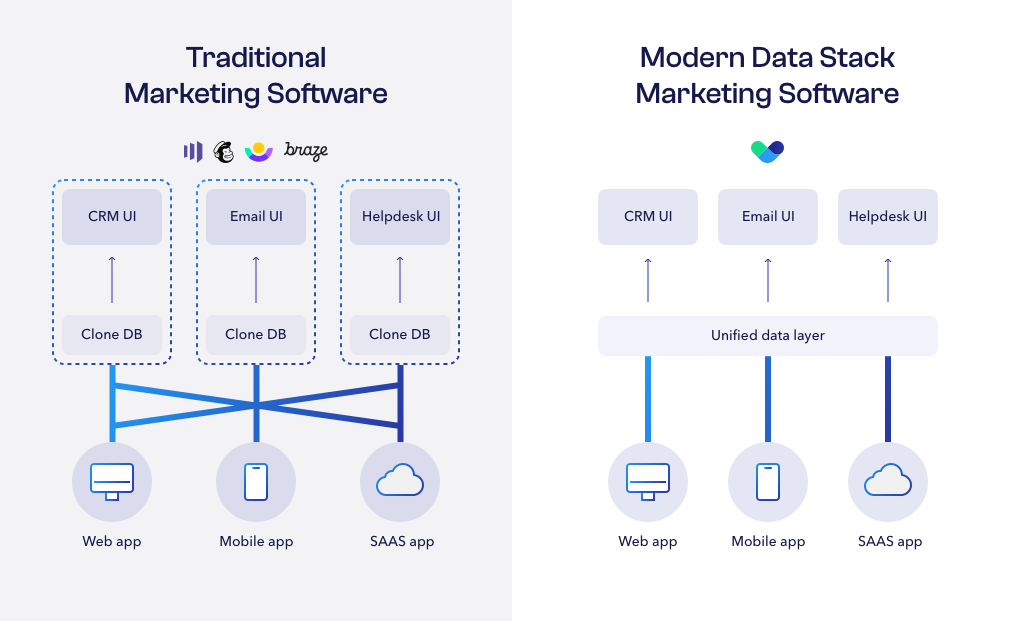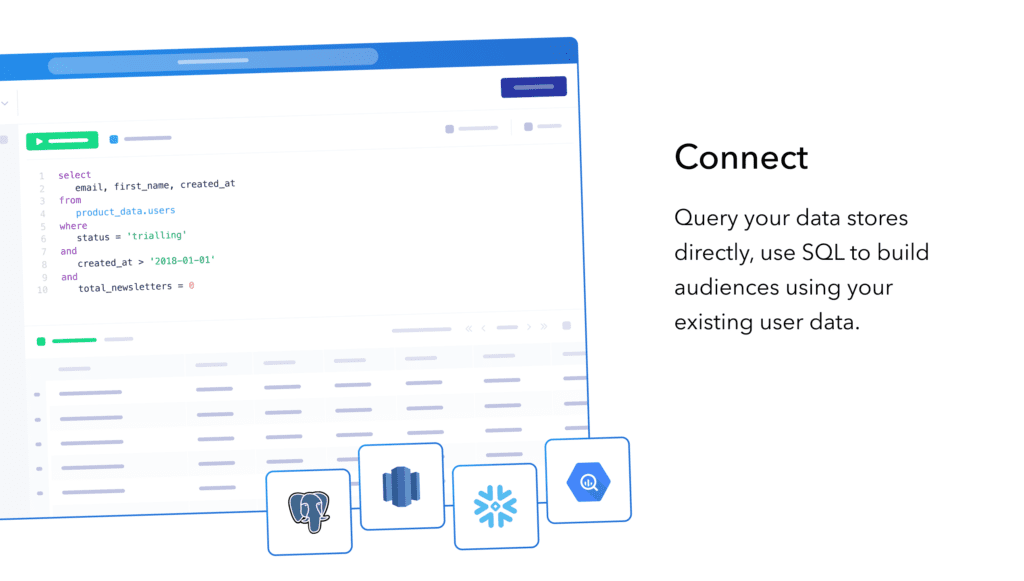- All Posts
- /
- Marketing Automation Software for the Modern Marketing Stack

Marketing Automation Software for the Modern Marketing Stack
Data Management-
 Nicole Kersh
Nicole Kersh
-
Updated:Posted:
On this page
With just about every tool, app, and webform collecting and storing user data, marketers now have access to more data than ever before. From an email marketing perspective, more data should technically mean more opportunity. If the data’s not centralized and accessible, it can be more an obstacle than an opportunity.
In traditionally siloed architectures, marketers find themselves relying on engineering or analytics teams to align, reconcile and query data from multiple sources. There’s often a massive amount of copying and duplication between various systems and data stores which results in overcomplicated, unsegmented email campaigns that take way longer to create than necessary.
When you sign up to a traditional email marketing platform, you’re essentially paying for two core things: marketing software and a Customer Data Platform (CDP). The problem with bundling both together is that you’re constraining your customer data to your email service provider.
While this scenario might make sense for a startup or small business it presents serious challenges for scaling businesses, and ultimately weds you to one vendor.
Marketing Sotfware for the Modern Data Stack<
Thanks to Cloud Data Warehouses (CDW) like Snowflake, Big Query, Snowplow, and dbt, user data can now be collected, stored, and accessed from a unified data pipeline. The modern data stack is fast becoming the default way for modern marketing and data teams to store, organize and manage user data. From an email marketing perspective, it’s a total game-changer.
With a warehouse-first approach, all the data you need to act on your sales and marketing activities is in one location. No more stitching and syncing of multiple sources. Just real-time, raw, accurate data in one unified pipeline. Before marketers can take advantage of a warehouse-first approach, they need to divorce their data from their email marketing software.
Vero Connect was built specifically for this scenario. Vero Cloud sits as a layer on top of a modern data stack, enabling marketers to access raw data from a CDW or database and create personalized campaigns at scale. It’s a powerful shift, giving modern marketers the ability to create highly-segmented, compelling campaigns faster than ever before.
Why Marketers Benefit From Accessing Data Directly From A CDW
More Control
When your data is stored within your email service provider, you’re reliant on their controls. Shifting to a centralized warehouse puts you in control. This is a huge advantage on two fronts: consumer transparency and data compliance. Consumers want to know where their data is stored and that it’s stored securely. If you’re relying on a third party, your user’s data is being copied and synced between multiple sources. From a regulatory perspective, certain industries like health, banking, fintech, and government, have stricter controls around privacy and security. Email marketing layers like Vero don’t store any customer data, making it an ideal use case for organizations that need more stringent controls.
Simpler Stack
Data silos require a lot more infrastructure to maintain multiple data pipelines. When your data is scattered across duplicative stores, running simple queries means copying and exporting data between locations. With duplication comes inefficiency and a lack of flexibility and you’re paying to keep the same data in two places. Modern marketers need the flexibility to act on accurate data in real-time. This isn’t straightforward when your data is constrained to your email service provider.
Tools like Vero connect directly to your data where it already exists, giving marketing teams access to a single source of truth while reducing technical overheads and resource-intensive applications.
More Opportunity
Modern marketers with large data pools need to be able to create more strategic segments within their campaigns. Having access to unified data opens new opportunities for granular personalization and segmentation not previously possible when your ESP holds the keys to your customer data.
Separating your email marketing from your CDP removes barriers to personalization, allowing marketing teams to execute faster, smarter campaigns.
Scalable Tooling
One of the major advantages of switching to a CDW is that and your data are not wedded to one particular vendor. Scaling is as simple as swapping out tools. As an example, SMBs could start with a simple “CRM” in Airtable, grow into Segment with PostgresSQL as a data warehouse. They could then scale to a full-blown Snowplow Analytics installation with Google BigQuery or build something custom on Kafka and S3. While your sources scale as your data grows, your messaging UI and experience remain consistent.
From an enterprise perspective, you can also plug in different data sources for different jobs within your organization. Your product PostgreSQL database for your product team, Airtable for your legal team, an analytics-only database for marketing and so many more.
Send Smarter With Vero Connect – Software built for the Modern Data Stack
Vero Connect was built around the idea that your customer messaging tools and your Customer Data Platform don’t need to be the same. Our modular approach to messaging separates customer data from messaging UI and sits as a neat layer on top of data warehouses like Snowflake, Postgresql, Oracle MySQL, BigQuery, Firebase or others. Direct data access makes it possible to query data within your data warehouse so you can build rich segments, test new use cases, and deliver powerful campaigns quickly, and at scale.



